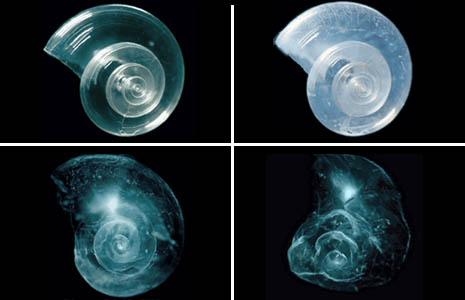
Secretary Kerry hosted a remarkable conference in June called simply Our Ocean. It enlisted international policy makers, scientists, and the private sector to take action to ensure a healthy ocean for the future. The conference laid out the science, impacts, and solutions for three critical ocean problems: sustainable fisheries, ocean pollution, and ocean acidification. A key goal was to alert those at the highest levels of government to the perils facing the ocean and to inspire them to act decisively to change course.
The normally staid State Department conference room was bathed in oceanic blue light and during breaks gentle whale songs played while whales and schools of fish swam across three walls of high resolution screens. An exhibit area featured NOAA's Science on a Sphere and NASA's Hyperwall both showing detailed movies of our dynamic planet.

NOAA Science on a Sphere. Photo from the Space Foundation.
The session on ocean acidification demonstrated that the adverse effects of carbon dioxide emissions are not limited to heating the planet. The acidity of the ocean has already increased by 30% because of added carbon dioxide. Simple chemistry says that trend will continue as long as extra carbon is added to the atmosphere. Bill Dewey of Taylor Shellfish Farms explained that oyster farmers on the U.S. West Coast are already adjusting their water management to minimize the damage caused by acidic waters. The COE of the Palau International Coral Reef Center, Yimnang Golbuu, showed that certain types of coral seem to be resistant to acidic waters, which may allow us to buy time for some reefs while we work to limit the extent of acidification. We also saw alarming photos of tiny sea butterfly (pteropod) shells that are already developing poorly because of acidity.

In a lab experiment, a sea butterfly (pteropod) shell placed in seawater with increased acidity slowly dissolves over 45 days. Photo: Courtesy of David Littschwager/National Geographic Society
The panelists made clear that acidification is a one-way street; once carbon dioxide makes its way into the sea, we cannot get it out.
Unlike marine pollution and overfishing, which require multifaceted solutions, ocean acidification has only one primary cause: excess carbon dioxide in the atmosphere. It therefore has an obvious solution: limit carbon emissions.
As Secretary Kerry said, the challenges of climate change and ocean acidification "actually have pretty obvious solutions that are staring us in the face. It’s not as if we’re sitting around scratching our heads saying, 'How do we solve the problem?' It’s really a question of, “How do we find the political will?'"
Political will comes from demands of citizens. But we need to apply pressure now because any political backbones that were strengthened by this conference could begin to dissolve in an acid political environment.
Posted by Sarah on Tuesday, 29 July, 2014
 |
The Skeptical Science website by Skeptical Science is licensed under a Creative Commons Attribution 3.0 Unported License. |